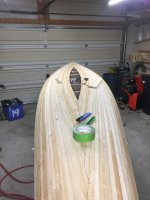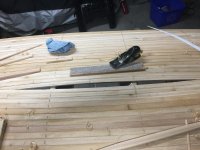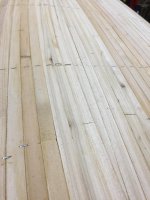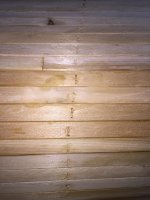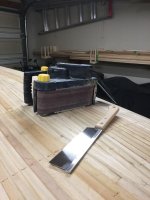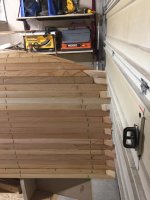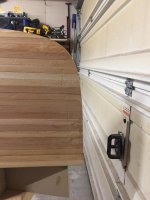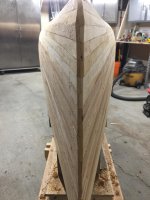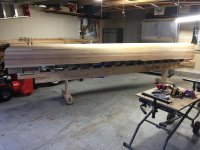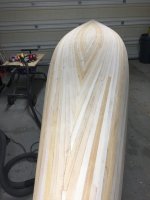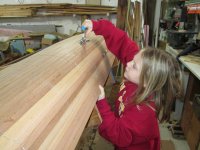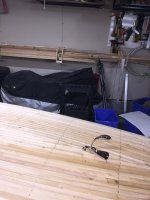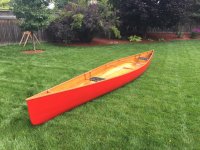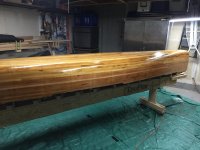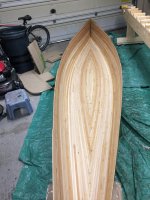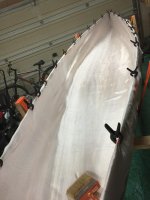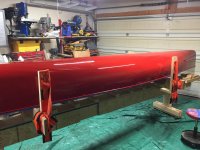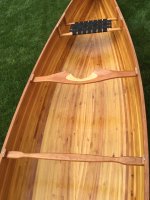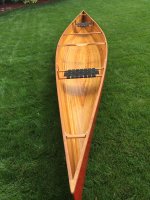So getting my ducks lined up for my next (second) build which will be a cedar strip tandem tripping canoe (medium duty). Haven't finalized what plans I will use yet, but it will be a 16.5 to 17 footer. Planning to use 3/16 strips, with 6 ounce s-glass in and out, and 4 ounce s-glass exterior football (and I have some 4 ounce e-glass on hand for the inside football if needed). Have the wood (eastern white cedar, and some western red) which I will start to process this week. I am going to finalize my glass and epoxy purchase today, which brings me to a couple of quick questions that I would appreciate your views/advice on before I complete my order.
1) the plans that I am interested in have a max beam of about 34 to 36 inches. My understanding is that you need to be careful using 3/16 strips for wider-beamed canoes (over say 30 inches), and at least one of the designs I am interested in suggests adding a keel or shoe keel to deal with bottom seam/joint stresses if using 3/16 strips. That would not be my preference but not the end of the world either I guess. But are there other ways to achieve the same result - e.g. a run of carbon tape down the bottom seam from end to end on the inside or outside, buried under the glass? Heavier glass for the football layer? Any thoughts on this from those who have built wider-beamed canoes using 3/16 strips?
2) is peel ply for a hand layup of the hull a "thing"? I have seen a few internet postings elsewhere where people have used 18-24 inch wide strips of peel ply, with slight overlaps, to get a smoother, low epoxy finish on large multi-dimensional shapes like a boat hull. I am pretty sure if this worked reasonably well for canoe builds some of the builders here would have been all over it for a while, but it doesn't really come up in any of the searches I have done here and elsewhere (aside from some great posts, notably those by Mike McCrae, on skid plates and small area hull repairs). I probably have my answer in that fact, but gotta ask if anyone has tried this with any success for the main hull layup.
That's it for now - will update periodically (hope to have the hull together and at least glassed before the deep chill sets in around Christmas).
Thanks all
Tony
1) the plans that I am interested in have a max beam of about 34 to 36 inches. My understanding is that you need to be careful using 3/16 strips for wider-beamed canoes (over say 30 inches), and at least one of the designs I am interested in suggests adding a keel or shoe keel to deal with bottom seam/joint stresses if using 3/16 strips. That would not be my preference but not the end of the world either I guess. But are there other ways to achieve the same result - e.g. a run of carbon tape down the bottom seam from end to end on the inside or outside, buried under the glass? Heavier glass for the football layer? Any thoughts on this from those who have built wider-beamed canoes using 3/16 strips?
2) is peel ply for a hand layup of the hull a "thing"? I have seen a few internet postings elsewhere where people have used 18-24 inch wide strips of peel ply, with slight overlaps, to get a smoother, low epoxy finish on large multi-dimensional shapes like a boat hull. I am pretty sure if this worked reasonably well for canoe builds some of the builders here would have been all over it for a while, but it doesn't really come up in any of the searches I have done here and elsewhere (aside from some great posts, notably those by Mike McCrae, on skid plates and small area hull repairs). I probably have my answer in that fact, but gotta ask if anyone has tried this with any success for the main hull layup.
That's it for now - will update periodically (hope to have the hull together and at least glassed before the deep chill sets in around Christmas).
Thanks all
Tony

